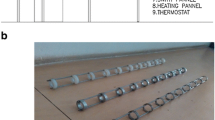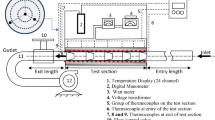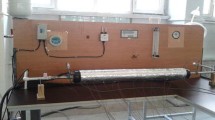Abstract
Heat transfer rate augmentation in heat exchangers with least pressure drop is one of the important fields for research in research fraternity. The different types of inserts have been used in the tube to fulfill the objective. In the present model, a conical-ring turbulators with protrusion and dimple roughness from inside has been used as an insert. These turbulators were placed inside the heat exchanger tube, and tube was applied with uniform heat flux condition. A parametric study has been performed for different diameter (3, 6 and 9 mm) and pitch space (60 and 240 mm) of protrusion and dimple. The Reynolds number has been varied from 5000–30,000, and heat flux of 1200 W/m2 was used. It was concluded that as pitch space and Reynolds number increases, Nusselt number also increases. The protrusion shaped roughness has better thermal performance factor than dimple shape. The diameter of 6 mm has performed better than 3 and 9 mm for both the cases of roughness.
Access provided by Autonomous University of Puebla. Download conference paper PDF
Similar content being viewed by others
Keywords
- Computational fluid dynamics
- Dimple shaped roughness
- Protrusion roughness
- Heat exchanger
- Thermal performance factor
1 Introduction
The heating and cooling systems have one of the essential components, i.e., heat exchanger. The application of heat exchanger are in various industries like oil organizations, residential areas, and solar applications [1, 2]. While designing a good heat exchanger, one has to analyze the parameters like heat transfer rate, fluid flow, pressure drop, etc. The passive techniques for heat transfer augmentation in heat exchanger have gained lot of attention nowadays because there is no extra power needed in that. The passive techniques includes surface treatment, i.e., hydrophobic and hydrophilic surface, roughened the surfaces, use of extended surfaces like fins and inserts, introduction of devices like displaced enhancement devices, and vortex generation devices. Other methods are also used by researchers like introducing foreign element in the coolant like nanofluids [3] and using phase change material, etc.
There are various inserts used by different authors for heat transfer augmentation in heat exchangers.
ThianPong et al. [4] uses insert in the form of twisted tape having perforations (PTT) in their study for heat transfer rate improvement. They observed that heat transfer rate has been significantly increased using PTT and also concluded with decrease in pitch ratio and twisted-tape ratio, there is increase in heat transfer rate.
Promvonge and Eiamsa-ard [5] use conical-ring and twisted-tape insert in a circular tube and concluded that this combination has over 10% enhancement in heat transfer rate from conical-ring alone case.
Promvonge [6] uses heat exchanger tube fitted with arrays of following conical-ring turbulator: Converging conical ring (CR), diverging conical ring (DR), and converging-diverging conical ring (CDR). He concluded that DR array has highest efficiency, CR has least and while CDR has in between them. Many researchers [5, 6] have performed studies on conical turbulator inserts in the heat exchanger tube for improvement of heat transfer rate and hot shortness problem.
To further enhance the performance of heat exchanger having conical turbulator, two different types of roughness has been investigated. The roughnesses implemented in the present study are:
-
1.
Conical ring with protrusion roughness
-
2.
Conical ring with dimple roughness.
2 Simulation Model
In present work, a heat exchanger tube has been analyzed numerically. The present heat exchanger tube model was modeled in commercial code ANSYS V14.0. The fluent module has been used to solve the present problem. The presented model has used conical ring with different roughness as a way to improve heat exchanger thermal performance. The conical-ring roughnesses used were protrusion roughness and dimple roughness.
The cone rings which were roughened with protrusion and dimple were shown in Figs. 1 and 2, respectively. In Fig. 1a, b, the side and isometric view were shown, respectively. These conical rings were placed inside the heat exchanger tube. The heat exchanger tube was shown by light gray color in these figures. These conical-ring roughnesses helps in heat transfer augmentation between tube surface and working fluid because of formation of turbulent eddies in the tube and disturbances in the boundary layer. The different type of protrusion roughness was shown in Fig. 1c–e and while different dimple roughness in conical ring was shown in Fig. 2a–c. In the present numerical study, k-e turbulence RNG– enhanced wall treatment model has been used. Various researchers like Alam and Kim [7] and Li et al. [8] have used similar models in their numerical study.
The total length (L) of heat exchanger tube is 1500 mm and is being divided into three section (i) Entrance section (L1 = 100 mm) (ii) test section (L2 = 1300 mm) where conical ring with roughness were inserted in the heat exchanger tube and (iii) exit section (L3 = 100 mm). The conical-ring insert are having base radius of 15 mm, top radius of 12 mm, and length of 40 mm. These conical rings were of same sizes and having same orientation, i.e., along the tube axis. The different design and working parameters used in the present numerical study were shown in the Table 1. The term pitch space (P) has been used to define the distance between two consecutive inserts and pitch ratio (PR) was the ratio of pitch space to the hydraulic diameter (Dh). The two sets of pitch space has been used, i.e., PR = 2 and PR = 8. The different inlet conditions were achieved by applying different Reynolds number (Re). The Re has been varied from 5000 to 30,000.
2.1 Assumption
To further simplify the numerical simulation, the following assumptions have been incorporated.
-
(1)
Steady and incompressible fluid flows
-
(2)
Pressure variation in Y direction is zero.
-
(3)
Neglecting body forces like gravity forces.
-
(4)
There is no variation in properties of air and copper with pressure and temperature, i.e., constant properties.
-
(5)
At the wall of the tube, no slip boundary conditions prevail and turbulence intensity was taken at 5%.
Based on the above listed assumptions, conservation of mass, momentum, and energy (Eqs. 1–3) equations have been solved.
where \( \vec{V} \) is the velocity vector matrix. The conical-ring insert and heat exchanger tube have been made of copper because it has high thermal conductivity and working fluid used is air. The thermos-physical properties of both tube and working fluid are shown in Table 2.
2.2 Mesh Generation and Grid Independence Test
The present model has been discretized in two different fashions. From outside of the tube, coarse meshing while at inside, fine meshing has been used. The grid independence test has been performed, and it was observed that after the 1,207,624 numbers of elements, Nusselt number does not increases much. Hence, in further analysis, the same grid size has been used.
3 Results and Discussion
3.1 Validation
The smooth plain tube model has been compared to check the accuracy of present model. On comparing the smooth tube model with Dittus-Boelter equation, the variation in Nu number is in range of 1–7%. The trend is observed for friction factor in smooth plain tube and Blasius friction equation. The present conical inserts inside the tube are also compared with Promvonge [6]. Figure 3 shows the variation plot of Nu with Re for present model and Promvonge [6]. It was founded that deviation of Nu was in acceptable range (4–8%).
Validation of present numerical model with Promvonge [6]
3.2 Heat Transfer
The Nusselt number (Nu) value gives a proper overview of heat transfer rate in any heat exchanging device. The Nu number variation with Re for different protrusion diameter was plotted in Fig. 4. The two sets of pitch have been used. In Fig. 4a, the value of P is 60 mm while in Fig. 4b, P is 240 mm.
It has been observed that with increase in Re, heat transfer rate also increases and highest Nu was achieved at maximum Re, i.e., (Re = 30,000). This was because as Re increases, more fluid flows through the tube and heat carried by it increases. It was also founded that higher pitch space has high heat transfer rate. The Nu value for P = 240 mm was higher than P = 60 mm for all the cases. This may be because more flow disturbance was created by pitch space of 240 mm. The d = 6 mm has shown highest Nu than d = 3 mm and d = 9 mm. There was significant improvement that can be seen in heat transfer rate in heat exchanger tube with conical ring with roughness when compared with smooth tube.
The similar trend has been also observed for dimple shape roughness as can be seen in Fig. 5. Here, also dimple diameter, d = 6 mm has shown highest value of Nu than compared to d = 3 mm and d = 9 mm.
3.3 Fluid Flow
The variation of friction factor with Re for protrusion roughness in conical-ring insert inside of heat exchanger tube at P = 60 mm and P = 240 mm was presented in Fig. 6. The friction factor decreases with increases in Re. The maximum pressure drop is obtained for d = 6 mm, while least is obtained in d = 9 mm. The pressure drop was more for all the cases of inserts than compared to the smooth tube because inserts present in the tube obstructs the fluid flow.
The similar trends can be seen in heat exchanger tube with dimple shape roughness in conical inserts. Figure 7 shows that for both pitch space (P = 60 and 240 mm), the same trend has been observed for dimple roughness as it was observed earlier for protrusion case.
3.4 Thermo-Hydraulic Factor
The thermo-hydraulic factor (THF) is a parameter which depicts the overall working performance of the heat exchanger tube. Generally, different method incorporated to enhance the heat transfer rate has an inherent disadvantage of increased pressure drop. The parameter THF shows that whether the modification done to achieve heat transfer augmentation was feasible or not. A particular design was considered a good design when THF value was greater than 1. Its expression was given by Webb and Eckert [9] which was shown in Eq. 4.
The variation of THF with Re for all the case has been plotted in Fig. 8. The protrusion roughness has shown higher value of THF than dimple roughness in conical ring for all sets of diameters. The thermal hydraulic performance was found highest for 6 mm diameter for both the roughnesses.
4 Conclusion
The heat exchanger tubes with inserts in shape of conical ring were used, and these conical rings are having roughness in the form of protrusion and dimples to further enhance the heat transfer rate. In the present numerical study, two parameters were studied, i.e., pitch space and protrusion/dimple diameter. The modification has been done with the objective to enhance heat transfer rate without significant increase in pressure drop. From the study, the following conclusion has been drawn:
-
1.
With the increase in Re, heat transfer rate increases and friction factor decreases for all the cases.
-
2.
Nu numbers increases from 1.45 to 3.19 times and friction factors increase from 1.36 to 1.96 times of plain tube case in the Re ranging from 5000 to 30,000.
-
3.
The Nu number increases with the pitch space between the conical rings inserts inside of the tube.
-
4.
The highest Nu has been obtained for protrusion roughness in conical ring with diameter of 6 mm.
-
5.
The lowest friction factor was founded for dimple roughness case in tube with diameter of 9 mm.
-
6.
The protrusion shaped roughness has better thermal performance factor than dimple shape for all the cases, and highest THF of 2.44 was obtained at Re = 30,000 for protrusion roughness case having diameter of 6 mm and pitch space of 240 mm.
Abbreviations
- c p :
-
Specific heat
- D :
-
Diameter (mm)
- D h :
-
Hydraulic diameter(mm)
- k :
-
Thermal conductivity
- P :
-
Pitch space
- f :
-
Friction factor
- Nu:
-
Nusselt number
- V :
-
Velocity matrix
- ρ :
-
Density (Kg/m3)
- µ :
-
Dynamic viscosity (Kg/m-s)
- c :
-
Channel
- o :
-
Plain tube
- Cu:
-
Copper
- air:
-
Air
References
Bhandari P, Varshney L, Bisht VS (2018) Numerical analysis of hybrid solar water heating system using wire screen packed solar air heater. In: 1st International conference on new frontiers in engineering, science & technology, vol 1, pp 415–1422
Varshney L, Bhandari P, Bisht VS (2014) Performance evaluation of hybrid solar water heating system using wire screen packed solar air heater. Int J Eng Res Appl (IJERA):311–316
Kumar N, Singh P, Redhewal AK, Bhandari P (2015) A review on nanofluids applications for heat transfer in micro-channels. Procedia Eng 127:1197–1202
Thianpong C, Eiamsa-ard P, Eiamsa-ard S (2012) Heat transfer and thermal performance characteristics of heat exchanger tube fitted with perforated twisted-tapes. Heat Mass Transf 48:881–892
Promvonge P, Eiamsa-ard S (2007) Heat transfer behaviors in a tube with combined conical-ring and twisted-tape insert. Int Commun Heat Mass Transf 34:849–859
Promvonge P (2008) Heat transfer behaviors in round tube with conical ring inserts. Energ Convers Manag 49:8–15
Alam T, Kim MH (2016) Numerical study on thermal hydraulic performance improvement in solar air heater duct with semi ellipse shaped obstacles. Energy 112:588–598
Li JL, Tang HW, Yang YT (2018) Numerical simulation and thermal performance optimization of turbulent flow in a channel with multi V-shaped baffles. Int Commun Heat Mass Transf 92:39–50
Webb RL, Eckert ERG (1972) Application of rough surfaces to heat exchanger design. Int J Heat Mass Transf 15(9):1647–1658
Author information
Authors and Affiliations
Corresponding author
Editor information
Editors and Affiliations
Rights and permissions
Copyright information
© 2021 The Author(s), under exclusive license to Springer Nature Singapore Pte Ltd.
About this paper
Cite this paper
Singh, B.P., Bisht, V.S., Bhandari, P. (2021). Numerical Study of Heat Exchanger Having Protrusion and Dimple Roughened Conical Ring Inserts. In: Sikarwar, B.S., Sundén, B., Wang, Q. (eds) Advances in Fluid and Thermal Engineering. Lecture Notes in Mechanical Engineering. Springer, Singapore. https://doi.org/10.1007/978-981-16-0159-0_14
Download citation
DOI: https://doi.org/10.1007/978-981-16-0159-0_14
Published:
Publisher Name: Springer, Singapore
Print ISBN: 978-981-16-0158-3
Online ISBN: 978-981-16-0159-0
eBook Packages: EngineeringEngineering (R0)












